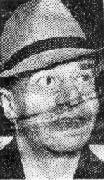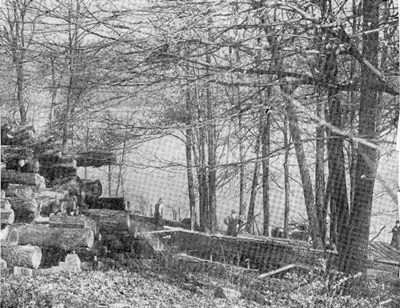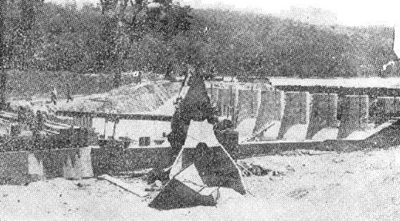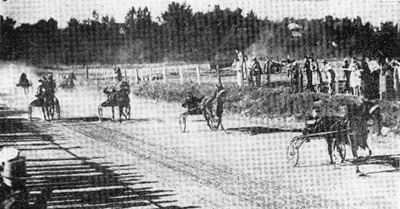
1
Arch Merrill
Down from the hills comes the voice of Hemlock, like the skirl of bagpipes, wild and haunting and a bit mournful. For Hemlock is a captive lake.
Long ago the arm of the great industrial city reached out to claim the six miles of narrow waters as its own. It chained the hill-girt lake to its chariot wheels with three long links of iron pipe hidden under Genesee Valley earth.
Through the years, Hemlock and her fellow captive, her lovely smaller sister, Canadice, have served their rich and powerful mistress well. Daily they mix a gigantic 34 million gallon cocktail for the big city to the southward. Yet the thirst of the city seems insatiable, as boundless as has been the pride of Rochester for nearly 70 years in her pure, upland water supply.
But Hemlock is no mere, drab, faithful old retainer.
She is a wild and elfin child of the hills and forest. None of the slim blue lakes of the Genesee Country has more physical allure. As you climb upward from the Springwater Valley along the wide, straight road that leads from the Southern Tier to Rochester, you catch your first glimpse of Hemlock’s slender grace. Sometimes the trees on the steep banks momentarily hide her from view. She is the more beautiful for her elusiveness.
Hemlock is a mountain lake although the conservatism of her people would never let them call old Bald Hill or her other rugged guardians anything but plain “hills.”
In the Indian tongue, Hemlock is Onehda and she is as rich in history and legend as she is in physical charm and utility.
In distant days before the Senecas became the masters of this domain, tribal fires glowed on her wooded hills. The lake was a favorite fishing and hunting ground for the Senecas and the braves came to her Eagle Rock, to hear the echo of their own voices and in their simple faith to believe they were communing with departed warriors.
Sullivan’s men forded Hemlock’s shallow waters at the northern end before they marched over the Marrowback hills to bivouac at Conesus and later to close the Western Door of the Long House.

2
This is truly the forest primeval, a part of the thickly wooded Hemlock Lake watershed, with the lake dimly visible in the background. Here workmen are salvaging the trees fallen from age and storm. Click the image to enlarge.
When in long gone autumns, the Senecas came to hunt and fish around the inlet of the lake, with them, year after year, glided a wilderness belle who was known as the handsome squaw and whose pulchritude became legend in pioneer days.
But in the fall of 1779, there were no warriors or savage beauties at Hemlock Lake. The Yankee army of General John Sullivan was on the march, ravaging the Seneca domain and sending the tribes fleeing before the awesome boom of his cannon. Sullivan’s army on Sept. 12 marched over the steep hills and dragged its guns through the narrow defiles from Honeoye, over the old Indian trail, made nearly impassible by rains. They stopped at what later became known as Short’s Flats to destroy fields of Indian corn, then forded the lake at its foot and ascended the rugged slopes between Hemlock and Conesus.
In 1790, the first white settler, Roswell Bliss, came. He built a cabin, a saw mill and a flat-bottomed scow. The latter he used to haul lumber down to the lake to his saw mill. Phillip Short came next, in 1795. His descendants still live in the village.
Three villages sprang up - Gullburg, now the southern end of Hemlock village where in an early day paint was made from the blue clay in which the place abounded; Jacksonville, on the flats northeast of the present village of Hemlock, and Slab City or Hemlock on the outlet.
Gullburg was soon absorbed by Slab City but Jacksonville was once a thriving town with distilleries, flour mills, a potash factory and even a public square. It has no real highway and was virtually inaccessible in winter. The settlers would barrel their flour and store it until spring, when they would haul it to Pittsford on the canal. Jacksonville vanished from the scene about 1846. The 70-year-old conduit of the Rochester water system, now undergoing repairs, runs through the heart of what once was Jacksonville. Historically minded Ernest Short, who lives in Hemlock village, showed me a wide-topped drinking glass that was a relic from the old distillery at Jacksonville. Seemingly it would hold half a pint. In pioneer days it held a drink of fiery native whisky that sold for three cents.
Hemlock grew and flourished. When the lumbering boom was at its height, so many settlers built their homes of wooden slabs around the outlet and the dam that the place became known as Slab City.
In 1880 a hermit named Meloy lived in a lonely log hut on the west shore of the lake. He hunted and fished all his waking hours and spoke to no one. One morning when rowing home after a fishing foray, he encountered a bear along the edge of the lake. The bear was hungry and went after the hermit. Bruin upset the boat and started to mount it. There ensued a strange sparring match. Meloy, wallowing in the water, would strike the bear with his oar and the animal would swing back with his paw. Finally the hermit drowned the bear and there was plenty of meat on the lonely table for many a moon.
I heard, too, at Hemlock tales of the old plank road that once ran to Rochester, of the winters when 200 teams hauled the lumber down the ice-locked lake to Slab City and of summers when the lake was full of timber-laden flatboats.
Then the pioneers came. Yankees skillful with ax and if needs be, with gun and fist. The whine of the saws echoed over the waters and bit by bit, the primeval hemlock forest came down and Slab City rose beside the outlet of the lake.
Hemlock had its day - and a pleasant one it was - as a summer resort. Once there were over 100 cottages and five hotels along her shores and five steamboats on her waters. Those were the days of the Jaques House and the Half Way House and the good ships, Clara Belle and Minnie Tefft, and the picnics and the excursions of long ago.
That era ended when the city’s need for Hemlock water became more insistent and Rochester came to own not only the lake, but much of the land along her shores.

3
Faded with age, this historic picture taken soon after the turn of the century shows the hull of the Cora Belle, last big boat to ply the waters of Hemlock, being hauled from the lake by an ancient threshing machine. The boat, whose captain was the late Frank C. Evershed, was taken to Irondequoit Bay. Click the image to enlarge.
A modest little “History of Hemlock,” written in 1883 by D.B. Waite, gives a picture of the lake in its heyday as a resort, Although Rochester six years before had tapped it for a water supply.
The lake was lined with cottages and five boats rode the blue waters. The first steamboat was the Seth Green, launched in 1874 to the strains of the Lima Coronet Band. It was dismantled in 1879. Then came H. J. Wemett’s Cora Belle; the Mollie Tefft, owned by a Rochester woman of that name; the Nellie, later rechristened the A. Bronson; the Camella and the Wave.
There were five hotels: The Half Way House, so named because of its location; the Port House, at the head of Hemlock; a stopping place for all the boats; the Lake Shore Hotel and Dance Hall; the St. James, from which all lake tours started, and the three-story Jacques, at the northwestern edge, with its rambling piazzas.
When in the early 1890s, Rochester embarked on a vast water expansion program, began raising the level of the lake and building a new tunnel and conduit, besides acquiring more and more land around the lake, Hemlock as a summer resort was doomed.
Some of the old-timers up there have never forgiven the city for that. But in the next breath they will tell up about the high prices the city has paid for the land.
Hemlock regards the city as an arrogant spendthrift. They raise their eyebrows up in the hill country at the thought of a hydraulic expert, no matter eminent in his profession, receiving $100 a day for his services - - on the days he works.
In 1872 the growing city of Rochester decided it could no longer rely on its old-fashioned springs and wells for its water supply. A private corporation had made a contract with the city to supply it with Hemlock water, had even laid some wooden pipe and built a reservoir near East Henrietta, whose outlines still remain. But this company lacked funds and could not fulfill its contract.
So the city decided to build its own system and turned to Hemlock because of the purity of the water, which could be sent coursing down the hills by gravity flow.
The first conduit, the one now under repair, was begun in 1873. The first water was turned into the pipes January 22, 1876. In 1877, 30 miles of pole line was constructed between Rochester and Hemlock Lake - then the longest telephone line in the world. As Mr. Bell’s invention was new and untried, the line was equipped with Morse instruments and telephones.

4
The Hemlock Lake spillway, part of the elaborate water system designed to assuage Rochester’s thirst, as it looked when being built in July of 1936. Click the image to enlarge.
The building of Conduit No. 2 in 1983-94, brought a considerable boom to the region. The city constructed two miles of brick-faced tunnel and old-timers recall the wagonloads of brick that rumbled down the roads and the excitement and rush of those construction days. Livonia and other neighboring towns shared in the boom. About that time the city began buying up large acreages around the lake and the cottages and hotels and boats began to disappear. The third Conduit was built in 1914-18.
Rochester owns 5,000 acres of land, 3,900 of which are forested, mainly with pine. Canadice and its outlet account for more than 18; the rest belong to the Hemlock area.
The city is in the farming business with both feet, with 325 acres of hay, 75 acres of oats and 22 acres of wheat, mostly in the Springwater Valley at the head of the lake. These crops help feed the horses that draw the city’s garbage wagons.
Rochester’s forest preserve is second only to that of New York City. A constant restoration program is under way. When the small pines were set out, they were thinned annually and the excess destroyed. Someone hit on the idea of selling them for Christmas trees. Rochester sold 7,500 of them in 1939, but for the past two years has not been in the Christmas tree business. For years a laboratory has been maintained at Springwater where an expert studies tree diseases and culture.
The city’s average daily water consumption is 34,000,000 gallons. During the depression it slumped to 26,000,000 gallons. It has reached the height of 45,000,000. So you see Rochester has quite a stake in Hemlock-Canadice water.

5
Guaranteed to give Hemlock villagers and residents for miles around a touch of nostalgia is this shot of trotters coming down the home stretch at the Hemlock Fair in 1941. The fair, best known as the famous old Slab City World’s Fair, is “out” for the duration, but will make a comeback after the war. Click the image to enlarge.
Hemlock village a bit of transplanted New England, sprawls for more than a mile along the main street. In the center of town is the yellow-painted Metropolitan Hotel with its sturdy concrete pillars. The hotel is 93 years old, the exact age of its proprietor, William Haggerty.
Haggerty at 93 is still a fine figure of a man, his skin as smooth, his bushy eyebrows as black, his wit as keen as in the days when he owned some of the best trotters in the countryside. William Haggerty remembers when, a barefoot boy, he walked all the way from his home in Lima to see the wonders of the Hemlock World’s Fair. It has been called that for years.
There are few villages the size of Slab City that have supported a fair for 74 years. The last two years the grounds have been deserted and sheep crop the grass where once crowds from Livonia and Honeoye and Lima and Canadice Corners and Springwater and the whole countryside gathered, come September.
In its best year, 22,000 passed through the World’s Fair turnstiles. As Doris Smith, the post mistress, put it, “the fair was where you always saw everybody you ever knew.” Hemlock misses its fair and hopes it returns with the dawn of peace.

6
Tucked away in the rolling hills overlooking the lake is St. Michael’s Mission House, whose grottos such as the one above bring an old world touch to the pastoral scene. Here one of the monks inspects grotto statuary. Click the image to enlarge.
On a hill high above the west shore of Hemlock Lake, a square, staunch, four-story stone building stands out in bold relief against the woods. It is St. Michael’s Mission House, where for ten years have dwelt and labored members of the order known as the Brothers of the Divine Word. The order was founded in Holland and has few branches in the east. At St. Michael’s high school pupils and graduates receive preparatory training for mission fields.
On the grounds of the mission house the good brothers have carved out of the rocky soil two grottos that house statues of the saints. They are the result of many hours of devoted toil. The dim light in the caves, the sacred shrines - there is a medieval air about this mission overlooking Hemlock water.
The site was once the country home of the most Rev. Bernard J. McQuaid, first bishop of Rochester. There he planted a vineyard on the slopes along the lake to provide the sacramental wine for the diocese. The Brothers of the Divine Word have expanded this vineyard until today they have a flourishing commercial wine business, besides supplying churchly needs.
The pioneers were forthright men. Sometimes they took the law into their own hands.
There was the time in 1825 after the completion of the Erie Canal when dams were built at the Western New York lakes as feeders for the canal. It turned out the canal did not need them but the dammed up water was very convenient for the owners of saw mills at the outlet of Hemlock. In spring and fall, the water would back up into the swampy woods at the head of the lake. In the summertime it dried up, leaving decaying substances that caused fevers among the citizenry.
The settlers at the head of the lake tired of this and urged that the dam be removed. The mill owners were deaf to these demands. One summer’s day 200 farmers mobilized and came down to the foot of the lake, with axes, crowbars and ropes. They proceeded to dismantle the dam and gates. The Slab City mill owners came to protest and remained to beg. The farmers yielded, the work of destruction halted and the “army” dispersed. But the next year they got permission from the state to remove the rest of the dam.
In 1866 a horde of squatters settled on the Springwater flats. The landowners forced them to leave. A riotous time ensued, with barns burned and stock slaughtered. Finally the two forces met in pitched battle. The landowners won and the squatters’ war went into history.
I am indebted to City Judge Arthur L. Wilder of Rochester, who lived as a boy at Webster’s Crossing, for a couple of tall tales of the hills.
A man named Mike Weaver, who lived on the edge of a swamp near the crossing, was the Baron Munchausen of the region. Here is one of his whoppers:
One day he went into the woods to trim the tops off fallen trees. He hitched his team to a load of the brush with a rope and started for his barn, never looking back. Imagine his surprise on arriving home to find the rope had stretched so that the tree tops were still in the woods while the team was in the barn. That night it rained and the rope contracted so that the brush came sailing down into his barn yard.
Another time Mike said he was driving a fast stepping team hitched to a wagon when a storm gathered. He whippied up his horses and outraced the oncoming storm. When he got home he found the back of his wagon full of hailstones but not one had touched him or his fabulously swift horses.
In 1890 the Lehigh Valley built its branch to the foot of the lake and drove a spike to mark the terminal. One night, so the tale goes, an Irish engineer became sleepy - or something - and arriving at the end of the line, thought he was at Livonia Center and drove the engine right into Hemlock Lake!
“A beautiful lake is the Canadice,
And wild fowl dream on its broad Expanse;
Thy golden broach of costly price
Is dim with its radiant wave
compared.”
So wrote the poet of the Genesee Valley, W. C. H. Hosmer, long ago.
Over the rugged hills in Ontario County, east of Hemlock, lies its radiant sister, Canadice, sparkling among wooded hills.
Canadice is only four miles long, but its Indian name, Shenadice, means “long lake.” For half a century it has, like Hemlock, been the captive of the city. It has given generously of its cool, spring-fed water. For about half a mile, cottages line the shores, mostly on the west side. Once rattlers were plentiful in the hills. Once, too, Canadice had many more cottages and was a picnic spot for the countryside. In those days Pere Moose’s place on the east shore was a favorite rendezvous. Now it is the residence of the city waterworks caretaker, and Canadice’s day as a resort is done.
“A beautiful lake is Canadice,
And tribesman dwelt on its banks of yore
But a hundred years have vanished thrice,
Since hearthstones smoked upon its shore.”
An ancient legend clings in the little lake in the woods. In the Fifteenth Century, the Munsee, a peaceful, little people, dwelt on a hill on Canadice’s western side. A fierce and warlike tribe, the Mengwees, raided the Munsee settlement and killed every member of the tribe save Onnolee, the beautiful wife of a leading chief.
The fair prisoner was tied to the red belt of the Mickinaw, the fierce chief of the invaders and was dragged away from her ravaged home. When the chief relaxed his vigilance for a moment, Onnolee, quick as light, seized the hunting knife from her captor’s belt and plunged it into his side.
Then knowing her life was forfeit, and while arrows whizzed past her head, she ran to the lakeside and chanting the death song of her people, “from the high rocks sprang.”
They say that in the time of falling leaves, when the moonlight on Canadice water, a plaintive song is heard in a strange tongue.
|






